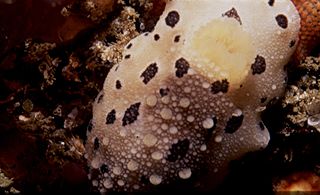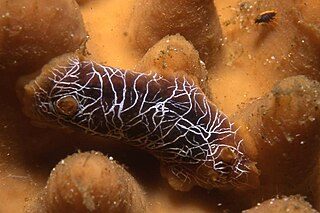
The clade Anaspidea, commonly known as sea hares, are medium-sized to very large opisthobranch gastropod molluscs with a soft internal shell made of protein. These are marine gastropod molluscs in the superfamilies Aplysioidea and Akeroidea.

Opisthobranchs is now an informal name for a large and diverse group of specialized complex gastropods which used to be united in the subclass Opisthobranchia. That taxon is no longer considered to represent a monophyletic grouping.

Heterobranchia, the heterobranchs, is a taxonomic clade of snails and slugs, which includes marine, aquatic and terrestrial gastropod mollusks.

The mantle is a significant part of the anatomy of molluscs: it is the dorsal body wall which covers the visceral mass and usually protrudes in the form of flaps well beyond the visceral mass itself.

Mollusca is the second-largest phylum of invertebrate animals after the Arthropoda. The members are known as molluscs or mollusks. Around 85,000 extant species of molluscs are recognized. The number of fossil species is estimated between 60,000 and 100,000 additional species. The proportion of undescribed species is very high. Many taxa remain poorly studied.

Acochlidiacea, common name acochlidians, are a taxonomic clade of very unusual sea snails and sea and freshwater slugs, aquatic gastropod mollusks within the large clade Heterobranchia. Acochlidia is a variant spelling.
Strubellia paradoxa is a species of freshwater slug, a shell-less freshwater gastropod, an aquatic gastropod mollusk within the clade Acochlidiacea.

Gastropteridae, the bat-winged slugs, is a family of sea slugs, gastropod molluscs in the superfamily Philinoidea of the clade Cephalaspidea, the headshield slugs and bubble snails. The greatest diversity of these colourful small slugs is in the tropical and sub-tropical Indo-Pacific region.

Mandela's nudibranch, Mandelia mirocornata, is a species of sea slug, a dorid nudibranch. It is a marine gastropod mollusc, the only member of the genus Mandelia and the family Mandeliidae. The genus and family name honor Nelson Mandela, the former President of South Africa.

The scribbled nudibranch is a species of sea slug, a dorid nudibranch. It is a marine gastropod mollusc in the family Dendrodorididae.

Pseudunela cornuta is a species of minute sea slug, an acochlidian, a shell-less marine and temporarily brackish gastropod mollusk in the family Pseudunelidae. Adults are about 3 mm long and live in the spaces between sand grains.
Aiteng is a genus of two species of sea slugs, marine gastropod molluscs and one terrestrial species. Aiteng is the only genus in the family Aitengidae. The generic name Aiteng is derived from the name of a black puppet Ai Theng, which is one of the shadow play puppets in southern Thailand.
Paraganitus ellynnae is a species of sea slug, an acochlidian, a shell-less marine gastropod mollusc in the family Microhedylidae.
Aiteng mysticus is a species of sea slug in the family Aitengidae, found around Hisamatsu, Miyako-jima, Okinawa, Japan. Morphologically it clearly belongs to the Aitengidae, but it shows differences to Aiteng ater at genus or species level. Its affinity to Aiteng ater is confirmed by comparison of the mitochondrial 16S rRNA sequences.
Thorunna daniellae is a species of sea slug, a dorid nudibranch, a shell-less marine gastropod mollusc in the family Chromodorididae.

Pontohedyle is a genus of sea slugs, acochlidians, shell-less marine gastropod mollusks in the family Microhedylidae. Sea slugs in this genus are highly simplified and uniform.

Pseudunela viatoris is a species of sea slug, an acochlidian, a shell-less marine gastropod mollusk in the family Pseudunelidae.

Pseudunela marteli is a species of sea slug, an acochlidian, a shell-less marine gastropod mollusk in the family Pseudunelidae.
Plocamopherus maculapodium is a species of sea slug, a nudibranch, a shell-less marine gastropod mollusk in the family Polyceridae.
Bathyhedyle boucheti is a species of panpulmonate slug, a deep-sea dwelling gastropod native to the continental slope off the coast of Mozambique. It is the first ever such panpulmonate slug to be discovered at such depths. It is the only known member of its family group. Its radular formula is 1.1.2.












